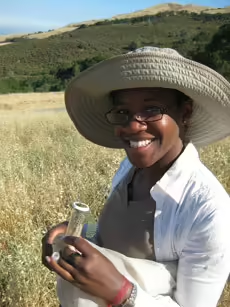URBANA, Ill. - University of Illinois Extension connects the research-based science to the communities it serves. To Extension Educator Kelly Allsup, the connection to science goes even deeper. "Our communities want to not only know the science; they want to contribute to it."
I-Pollinate is a citizen-science research initiative through University of Illinois at Urbana-Champaign designed to collect statewide pollinator data. Volunteers may join as many as three research projects: monarch butterfly egg and caterpillar abundance, pollinator visitation to ornamental flowers, and bumblebee and honey bee distributions.
Three university scientists lead research efforts for the I-Pollinate project. "Extension will highlight the scientist and their work as we invite individuals to become I-Pollinate citizen scientists," Allsup says.
Alexandra Harmon-Threatt is an assistant professor at Illinois' Department of Entomology. Her research focuses on pollination ecology. For nearly two decades, she has research how pollinators respond to disturbances, as well as the role invasive plants have on bee diet and nutrition. In addition, she investigates habitat fragmentation on bee communities and how fire and habitat management impact those communities.
“We’ve discovered bees can be very resilient,” Harmon-Threatt says. In her work with the I-Pollinate project, she is assessing the attractiveness of common annual ornamental plants. This data will help provide options to gardeners interested in supporting pollinators with non-native plants.
“Scientists have known for a long time that the context of a plant matters for how attractive it is to pollinators. Is it close to other plants? Are there many blossoms or very few? Is it in a neighborhood or area with many attractive plants?
"Accurately capturing the wide diversity of context for plants is incredibly hard for scientists because it requires a lot of locations and a lot of data. Citizens recording and reporting on how a plant performs in their yard provides rich data on this context-dependent performance that would be almost impossible for scientists to collect without their help,” says Harmon-Threatt.
In 2015, Harmon-Threatt began assessing the attractiveness of ornamental plants for the Champaign Parks District in a project called CU Pollinator Count. The project eventually expanded to Urbana Parks.
“With Extension help, we can expand to home gardens around the state, says Harmon-Threatt.
The work began as a personal interest first as Harmon-Threatt considered creating pollinator habitats in her Urbana home. She began incorporating native pollinator plants, but says she quickly realized most of those species were very tall and not conducive to front yards where the regulations limited vegetation to 36 inches tall. She observed that some, though not all, of the ornamental plants around the yard and neighborhood were still getting lots of visits. As a scientist, she could find no scientific recommendations on these ornamental plants and said she thought it would be good to start recording data on them.
Countless ornamental blossoms are planted in yards and baskets every year; yet, there is little data on whether some of these might be attractive to pollinators and able to help support them in some way. Ornamentals are unlikely to ever replace native plants, but they could provide more options for people to plant, Harmon-Threatt says.
“Getting people to start seeing all the pollinators in their yards has been amazing. So many people have written about what they are learning," she adds. The preliminary data is also showing how many of the most purchased annual plants are not of interest to pollinators.
Harmon-Threatt believes improving pollinator conservation at home is one way people can help reduce insect losses. "Most of us can’t directly control the pollution and pesticides in agriculture, but we can control what plants are in our yards and making them pollinator friendly.”
The losses of insects threaten entire ecosystems from the plants they pollinate to the birds and mammals that eat plant materials or use them to make nests. Visit I-Pollinate to learn how to contribute to Harmon-Threatt’s study of pollinator visitation to ornamental flowers.
SOURCE: Alexandra Harmon-Threatt, Assistant Professor, Illinois' Department of Entomology
SOURCE: Kelly Allsup, University of Illinois Extension, Horticulture Educator
